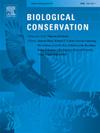Ecological mechanisms of canopy thinning: Insights into biodiversity recovery in neglected coppice
IF 4.4
1区 环境科学与生态学
Q1 BIODIVERSITY CONSERVATION
引用次数: 0
Abstract
Abandonment of traditional management is among the major causes of the loss of temperate forest biodiversity. While numerous studies highlight the positive impact of restoring traditional forest management on biodiversity, there is a notable gap in research focusing on the ecological mechanisms underlying the benefits to taxonomic, functional, and phylogenetic diversity.
In this study, we applied canopy thinning of various intensity in an abandoned coppice to examine the response of vascular plant, ant, carabid and spider communities to the thinning intensity.
Our results showed that the increase of functional diversity following canopy thinning is driven by the increased presence, rather than abundance, of species exhibiting unique combinations of ecological traits. Plant and invertebrate communities were not clustered or overdispersed within the phylogenetic or functional space delimited by the species pool, indicating the dominant effect of stochastic processes on community assembly.
Our multispecies study demonstrates for the first time that ecological mechanism maintaining biodiversity following forest thinning are mainly governed by stochastic processes. Notably, our research reveals that the increase in species richness after tree thinning is due to the presence of species with unique ecological trait combinations. Furthermore, we identified distinct mechanisms driving community changes: carabid beetles and ants mainly experience shifts in species composition, while plants and spiders are more affected by species loss.

林冠间伐的生态机制:对被忽视灌木林生物多样性恢复的认识
放弃传统管理是温带森林生物多样性丧失的主要原因之一。虽然许多研究强调了恢复传统森林管理对生物多样性的积极影响,但在关注分类、功能和系统发育多样性益处的生态机制方面的研究存在明显空白。本研究通过不同强度的林冠间伐,研究了维管植物、蚂蚁、瓢虫和蜘蛛群落对间伐强度的响应。我们的研究结果表明,林冠减薄后功能多样性的增加是由具有独特生态特征组合的物种的存在而不是丰度的增加所驱动的。植物和无脊椎动物群落在物种池划定的系统发育或功能空间内没有聚集或过度分散,表明随机过程对群落聚集起主导作用。我们的多物种研究首次证明了森林间伐后维持生物多样性的生态机制主要受随机过程控制。值得注意的是,我们的研究表明,树木间伐后物种丰富度的增加是由于具有独特生态性状组合的物种的存在。此外,我们还发现了驱动群落变化的不同机制:瓢虫和蚂蚁主要经历物种组成的变化,而植物和蜘蛛更多地受到物种损失的影响。
本文章由计算机程序翻译,如有差异,请以英文原文为准。
求助全文
约1分钟内获得全文
求助全文
来源期刊

Biological Conservation
环境科学-环境科学
CiteScore
10.20
自引率
3.40%
发文量
295
审稿时长
61 days
期刊介绍:
Biological Conservation is an international leading journal in the discipline of conservation biology. The journal publishes articles spanning a diverse range of fields that contribute to the biological, sociological, and economic dimensions of conservation and natural resource management. The primary aim of Biological Conservation is the publication of high-quality papers that advance the science and practice of conservation, or which demonstrate the application of conservation principles for natural resource management and policy. Therefore it will be of interest to a broad international readership.
 求助内容:
求助内容: 应助结果提醒方式:
应助结果提醒方式:


